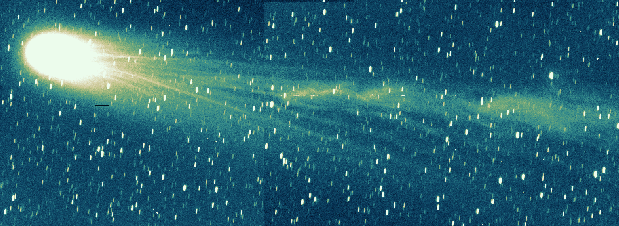Credit & Copyright: Herman Mikuz,
Crni Vrh Observatory,
Slovenia
Explanation:
The above false-color picture of Comet Hyakutake taken just two days
ago shows its rapidly developing tail. The comet now has a substantial
coma with
a bright center, lending it a
dramatic eye-like appearance.
This is not
Comet
Hyakutake's first visit to the inner Solar System.
Recent
orbital determinations clearly show
Comet
Hyakutake's was here
before, although the previous approach is estimated to be about 8600
years ago - during the epoch of the first recorded human cities.
Were this the comet's first trip to the
inner Solar System, it probably
would not appear as bright as it does now - first time comets typically do
not shed as much luminous gas as veterans. Before making any approach
to the inner Solar System,
Comet
Hyakutake was dormant in the
Oort
cloud of the outer Solar System for a few
billion years, along with hundreds of thousands of similar comets.
Comet Hyakutake is predicted to become the brightest comet since
Comet West
in 1976, which rivaled the brightest stars in the sky.
Tonight,
Comet Hyakutake can be seen best
from about 10 pm
near the Big Dipper's handle.
Latest Comet Hyakutake images: Crni Vrh Observatory, Slovenia, Fayetteville Observer-Times
1999 2000 2001 2002 2003 2004 2005 2006 2007 2008 2009 2010 2011 2012 2013 2014 2015 2016 2017 2018 2019 2020 2021 2022 2023 2024 2025 |
Yanvar' Fevral' Mart Aprel' Mai Iyun' Iyul' Avgust Sentyabr' Oktyabr' Noyabr' Dekabr' |
NASA Web Site Statements, Warnings, and Disclaimers
NASA Official: Jay Norris. Specific rights apply.
A service of: LHEA at NASA / GSFC
& Michigan Tech. U.
|
Publikacii s klyuchevymi slovami:
comet - comet Hyakutake - oblako Oorta - koma - komety - kometnye hvosty - kometa Hiyakutake
Publikacii so slovami: comet - comet Hyakutake - oblako Oorta - koma - komety - kometnye hvosty - kometa Hiyakutake | |
Sm. takzhe:
Vse publikacii na tu zhe temu >> | |
